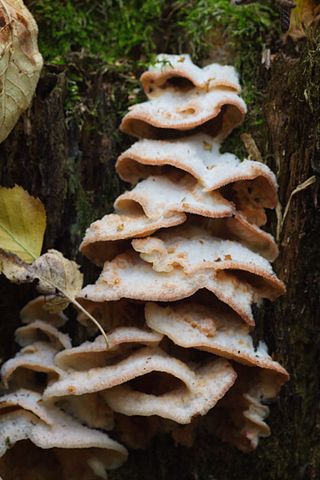Related Research Articles

Phanerochaete is a genus of crust fungi in the family Phanerochaetaceae.

The Meruliaceae are a family of fungi in the order Polyporales. According to a 2008 estimate, the family contains 47 genera and 420 species. As of April 2018, Index Fungorum accepts 645 species in the family.

The Phanerochaetaceae are a family of mostly crust fungi in the order Polyporales.
Candelabrochaete is a genus of crust fungi in the family Phanerochaetaceae.

Phlebia is a genus of mostly crust fungi in the family Meruliaceae. The genus has a widespread distribution. Phlebia species cause white rot.

Mycoaciella is a genus of corticioid fungi in the family Meruliaceae. The genus was circumscribed by John Eriksson and Leif Ryvarden in 1978. After microscopic examination of the three species then in the genus, Karen Nakasone proposed to synonymize Mycoaciella with Phlebia.

Mycoacia is a genus of toothed crust fungi in the family Meruliaceae. It was circumscribed by Dutch mycologist Marinus Anton Donk in 1931.
Roseograndinia is a fungal genus in the family Phanerochaetaceae. It is a monotypic genus, containing the single crust fungus species Roseograndinia rosea, recorded from tropical east Africa and from New Zealand.

Phlebiopsis is a genus of poroid crust fungi in the family Phanerochaetaceae. The genus contains 11 species, which collectively have a widespread distribution. The genome sequence of the type species, Phlebiopsis gigantea, was published in 2014.
Hjortstamia is a genus of poroid fungi in the family Phanerochaetaceae. It was circumscribed by French mycologists Jacques Boidin and Gilles Liège in 2003.
Australicium is a genus of two species of crust fungi in the family Phanerochaetaceae. The genus was circumscribed by mycologists Kurt Hjortstam and Leif Ryvarden in 2002 to contain the type species, A. singulare, which is found in New Zealand. The Venezuelan species A. cylindrosporum was added to the genus in 2005.
Amethicium is a fungal genus in the family Phanerochaetaceae. A monotypic genus, it contains the single species Amethicium rimosum, a crust fungus first reported from Tanzania in 1983. Amethicium is primarily characterized by its purple fruit body and a dimitic hyphal system. The felt-like tissue layer covering the substrate comprises a thin layer of densely intertwined skeletal hyphae.

Bjerkandera is a genus of wood-rotting fungi in the family Meruliaceae.

Hydnophlebia is a genus of five species of toothed crust fungi in the family Meruliaceae. All species are wood-decay fungi that cause a white rot.
Pirex is a fungal genus in the family Meruliaceae. It is a monotypic genus, containing the single crust fungus Pirex concentricus. It is found in the Pacific Northwest region of North America, where it causes a white rot in woody hardwood and conifer debris generated by timber harvesting.

The corticioid fungi are a group of fungi in the Basidiomycota typically having effused, smooth basidiocarps that are formed on the undersides of dead tree trunks or branches. They are sometimes colloquially called crust fungi or patch fungi. Originally such fungi were referred to the genus Corticium and subsequently to the family Corticiaceae, but it is now known that all corticioid species are not necessarily closely related. The fact that they look similar is an example of convergent evolution. Since they are often studied as a group, it is convenient to retain the informal (non-taxonomic) name of "corticioid fungi" and this term is frequently used in research papers and other texts.
Globuliciopsis is a genus of two species of crust fungi in the order Polyporales that are found in Central and South America.

Hydnophlebia omnivora is a species of crust fungus in the family Meruliaceae. It causes white rot in various woody angiosperms, being found in arid regions of the Southern United States, northern Mexico, and Uruguay.
Mycoacia rubiginosa is a species of toothed crust fungus in the family Meruliaceae. It was described as a new species in 2004 by mycologists Kurt Hjortstam and Leif Ryvarden. The type collection was made in Sierra Nevada de Santa Marta, in Magdalena, Colombia, where the fungus was found growing on dead hardwood. It is known only from the type locality. Fruit bodies of M. rubiginosa are distinguished by their reddish colour, and spines up to 3 mm (0.12 in) long. The hyphal system is monomitic, containing only generative hyphae. The spores are ellipsoid, smooth, thin-walled and translucent, with dimensions of 4–4.5 by 2.5–2.75 µm.

Phlebia tremellosa, commonly known as trembling Merulius or jelly rot, is a species of fungus in the family Meruliaceae. It is a common and widely distributed wood-decay fungus that grows on the rotting wood of both hardwood and conifer plants.
References
- ↑ "GSD Species Synonymy: Crustodontia chrysocreas (Berk. & M.A. Curtis) Hjortstam & Ryvarden". Species Fungorum. CAB International. Retrieved 2016-10-04.
- ↑ Lombard, Frances F.; Burdsall, Harold H.; Gilbertson, Robert L. (1975). "Taxonomy of Corticium chrysocreas and Phlebia livida". Mycologia. 67 (3): 495–510. doi:10.2307/3758388. JSTOR 3758388.
- ↑ Hjortstam, K.; Ryvarden, L. (2005). "New taxa and new combinations in tropical corticioid fungi, (Basidiomycotina, Aphyllophorales)". Synopsis Fungorum. 20: 33–41.
- ↑ Berkeley, M.J. (1873). "Notices of North American fungi". Grevillea. 1 (12): 177–180.
- ↑ Bernicchia, A.; Gorjón, S.P. (2010). Fungi Europaei – Corticiaceae s.l. Vol. 12. Edizioni Candusso. p. 245. ISBN 978-8890105791.
- ↑ Yurchenko, Eugene; Kotiranta, Heikki (2011). "Rare or little known corticoid basidiomycetes from southern Belarus". Mycotaxon. 115: 383–400. doi: 10.5248/115.383 .
- ↑ Binion, Denise; Stephenson, Steve; Roody, William; Burdsall Jr., Harold H.; Miller Jr., Orson K.; Vasilyeva, Larissa (2008). Macrofungi Associated with Oaks of Eastern North America. Morgantown, West Virginia: West Virginia University Press. p. 261. ISBN 978-1-933202-36-5.
- ↑ Larsson, Karl-Henrik (2007). "Re-thinking the classification of corticioid fungi". Mycol. Res. 111 (9): 1040–1063. doi:10.1016/j.mycres.2007.08.001. PMID 17981020.
- ↑ Papp, Viktor; Dima, Bálint (2018). "New systematic position of Aurantiporus alborubescens (Meruliaceae, Basidiomycota), a threatened old-growth forest polypore". Mycological Progress. 17 (3): 319–332. doi:10.1007/s11557-017-1356-3. S2CID 46770995.